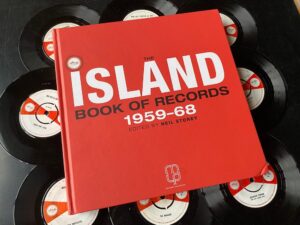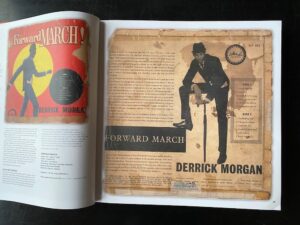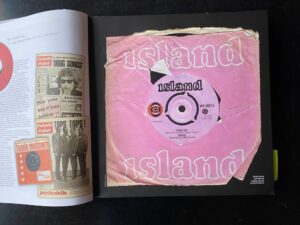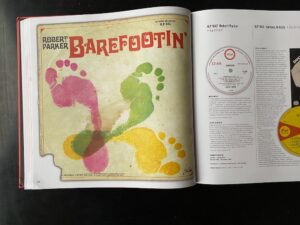Recently published by Manchester University Press, Neil Storey’s ‘The Island Book of Records 1959 – 68’ has so much music contained within its pages, it’s impossible not to hear it when reading, writes Cally Callomon.

“I’m not a collector, just not. I was always looking forward, never really collecting stuff as I went along” — Chris Blackwell
It was not so long ago, after a six year undertaking — writing a fully illustrated book on the songs of Nick Drake; a book that I hoped was more entertaining than scholarly — when I could not find a publisher who saw it as anything but a ‘music book’ (“they don’t sell”). A music book that they said ought to be a paperback with some shiny photos stuffed into the middle pages.
I felt a point was being missed and that point was: the book as a form of entertainment as opposed to mere words on paper or research tool. I was in luck with one ancient publisher who honoured it as a full colour expensive hardback and what do you know? Several years later, it still sells well. At full price.
So many of the books reviewed in Caught by the River adhere to the notion that a book has to feel, look and smell beautiful otherwise what’s the point? The alternative is a cheap 700 page paperback detective novel which may as well exist as words-on-a-screen or simply be devoured on a long flight and left on some faraway beach.
My original copy of an Island Book Of Records was a tiny catalogue given away free in Delmars Music Shop (Potters Bar) in the early 1970s and it was in that tiny tome I noted the sheer variety of records on that label, copies of which I bought — each and every one. Then as a happy art student I took on a part time job at Harum Records in Watford and noticed how The Wailers’ Catch a Fire and the debut Roxy Music album sold to the same customer at the same time and, yes, both were on the same label and both got the gatefold sleeve treatment. This was significant, I thought. I subsequently followed Island and all who sailed in it.
Then throughout the 1990s I was Art Director at Island Records. We kept a pretty comprehensive physical archive of all releases, handouts, photos and posters, the thrilling history of the place seemed to guide our every step and many an act was signed to the label because of that Palm Tree. Our history was framed and hung on the walls.
Universal swallowed up Island Records and that archive was no more, as is often the case with corporate mindsets — why spend money on a room of old stuff when the company is only judged by the success of the new? I’d left by then; the two occurrences are probably related.
So where does the history of that great company reside? As is so often the case, the archive is carefully guarded in private hands.
It’s taken Neil Storey, a man who once headed up Island’s publicity department, many years to document this archive and, at last, the first volume is now in print. Coincidentally Storey also found it hard to find a home for this book and luckily the Manchester University Press have seen past the gatekeepers W. and H. Smiths (try not to laugh at their new shop logo won’t you?) What Storey has achieved is that the book is scholarly, entertaining, lavish and beautiful all at the same time. Many of us would agree that the look of music is as vital as the sound of music (“the hills are alive” etc) but this whopping 390 page all-colour first volume (1959 – 1968) has so much music contained within it’s impossible not to hear it when reading.
I have to be even-handed here because this book was greatly aided by those few employees at Universal, the parent company, who are still held in the Island spell.
Most of the Island Records story has been told in refracted sound-bites for impatient documentaries or it has seeped into the odd autobiography but here we have the most important segment of that old lost archive patiently spread throughout with space and time to spare.

The book takes us from early Caribbean routes, James Bond, The Mighty Sparrow, Rugby Songs, Steel Bands, via ska and early London antics via Guy Stevens, Sue Records, Spencer Davis, pink labels, Winwoods, Chrysalis, Joe Boyd, Sandy and Fairports, with a comprehensive listing of all 45s and LPs on the home label and offshoots galore.
The details are exhaustive, the images beautiful and wonderfully laid out in an unfussy clear manner that never overpowers the original sleeves.
Storey is clearly a man who has read the recent article — ahem — as Page 15 boasts his own first Island purchase with his name proudly written on the label, in my view doubling its value.

I mean, who would want their copy of ‘Paper Sun’ made off with at Sarah’s 18th birthday party disco? Quite.
… and so back to books and their role in 2024. I am building a library here on my plot, based on the corrugated flat-packed 18th century temples by Boulton And Paul of Norwich, it will house a collection of books open to the public, inspired by the Gladstone library in Hawarden, a place to camp, browse and stay awhile… Most of the books will have been reviewed on this very site but there will also be a donated cycling library, art and photography books and much else besides. It will be of little value to scholars, academics and researchers as ‘the internet’ is now their first port-of-call. No, it will be there to pour a little glass, light a stove and sit awhile surfing aimlessly through beautiful books like this, so many of them ex-libris of old, donated to a new home and into an old habit that dies hard.
Storey’s admirable book is appropriately large — an almost 12” square format printed on the aptly named Gutenberg Press of Malta, a bible none the less.

There will be more books like this: just you watch, but this particular topic is now done, no need to repeat. Ever. Roll on volume two.
*
The Island Book of Records Volume 1 is out now and available here.